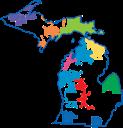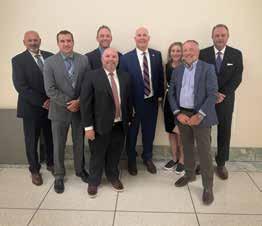

MICHIGAN COUNTRY LINES
Saving is believing.

Think you can’t afford a geothermal heat pump?
After a closer look, you may be surprised at its overall affordability. Tax rebates can quickly bring down the initial costs of purchase and installation. And a geothermal heat pump is much cheaper to run than the most efficient furnaces and air conditioners. In fact, your energy bills can be cut by as much as 70%. As a result, many geothermal homeowners see a return on investment of 10-20% over the life of their system. When you crunch the numbers, you’ll see WaterFurnace is the money-saving choice. To learn more, contact your local WaterFurnace dealer today.
Geothermal is the only renewable that provides reliable operation 24 hours a day, 7 days a week, 365 days a year.
Allendale
Allendale Htg & Clg (800) 327-1937 allendaleheating.com
Berrien Springs WaterFurnace Michiana (269) 473-5667 gogreenmichgeo thermal.com
Big Rapids Stratz Htg & Clg, Inc. (231) 796-3717 stratzgeocomfort.com
Filion/Bad Axe
Air-O-Dynamic Htg & Clg (989) 582-0137 aod-hvac.com
Grand Rapids
Bel Aire Htg & Clg
1-888-235-2473 belaire.com
Hart Adams Htg & Clg (231) 873-2665
Holland G.H.P. Systems Inc. (616) 396-5833 ghpsystems-inc.com
Indian River M&M Plmb & Htg (231) 238-7201 mm-plumbing.com
Lansing Candor Mechanical (517) 920-0890 candormechanical.com
Michigan Center Comfort 1/Air Serv of Southern Michigan (517) 764-1500 airserv.com/southernmichigan/
Mt Pleasant
Walton Htg & Clg (989) 772-4822 waltonheating.com

Portage
Bel Aire Htg & Clg
1-888-235-2473 belaire.com
Portland ESI Htg & Clg (517) 647-6906 esiheating.com
Sunfield
Mark Woodman Plmb & Htg (517) 886-1138 mwphonline.com
Three Rivers
Bel Aire Htg & Clg
1-888-235-2473 belaire.com
Traverse City
Geofurnace Htg & Clg (231) 943-1000 geofurnace.com

Alger
Electric: up to $2,000
C h erryland Electric: up to $2,500
Cloverland: up to $6,275
Great Lakes Energy: up to $5,000
H omeworks/Tri-County Electric: up to $4,750
Presque Isle Electric & G as Co-op: up to $4,750
Thumb Electric: up to $2,000


MICHIGAN COUNTRY LINES
EXECUTIVE EDITOR: Casey Clark
EDITOR: Christine Dorr
GRAPHIC DESIGNER: Karreen Bird
RECIPE EDITOR: Christin Russman
COPY EDITOR: Yvette Pecha
CONTRIBUTING EDITOR: Emily Haines Lloyd
PUBLISHER: Michigan Electric Cooperative Association
Michigan Country Lines, USPS591-710, is published monthly, except August and December, with periodicals postage paid at Lansing, Mich., and additional offices. It is the official publication of the Michigan Electric Cooperative Association, 201 Townsend St., Suite 900, Lansing, MI 48933.
Subscriptions are authorized for members of Alger Delta, Cherryland, Great Lakes, HomeWorks Tri-County, Midwest Energy & Communications, Ontonagon, Presque Isle, and Thumb electric cooperatives by their boards of directors.
POSTMASTER:
Send all UAA to CFS.
ASSOCIATION OFFICERS:
Chris O’Neill, HomeWorks TriCounty Cooperative, chairman; Gabe Schneider, Cherryland Electric Cooperative, vice chairman; Shaun Lamp, Great Lakes Energy Cooperative, secretary-treasurer; Craig Borr, president and CEO.
CONTACT US/LETTERS TO EDITOR: Michigan Country Lines 201 Townsend St., Suite 900 Lansing, MI 48933 248-534-7358 editor@countrylines.com
CHANGE OF ADDRESS: Please notify your electric cooperative. See page 4 for contact information.
The appearance of advertising does not constitute an endorsement of the products or services advertised.
MICHIGAN’S ELECTRIC COOPERATIVES




MI CO-OP Community
RECIPE CONTEST
See details on page 10. Summer Desserts, due April 1; Sandwiches & Wraps, due May 1. Win a $100 bill credit!
GUEST COLUMN
See details on page 18. Share your fondest memories and stories. Win $200 for stories published!
MYSTERY PHOTO
See details on page 18. Win a $100 bill credit!
To enter contests, submit reader content & more, visit countrylines.com/community
6 CRAIG BORR: A LEGACY OF LEADERSHIP & SERVICE
Borr’s unwavering advocacy for co-op members made MECA what it is today.
10 MI CO-OP KITCHEN
Best No Bake Recipes: Delicious desserts in no time.
14 BLOOM WHERE YOU’RE PLANTED: THE JOURNEY OF KALIN SHEICK
Sheick’s “why not” philosophy took her from TV journalism to founding a successful floral shop.
18 GUEST COLUMN
Farmyard Memories: A Great Lakes Energy member reflects on life with his father and their chickens.
THUMB ELECTRIC COOPERATIVE
2231 Main Street
Ubly, MI 48475-0157
1-800-327-0166 or 989-658-8571
E-mail: tec@tecmi.coop
BOARD OF DIRECTORS
HURON COUNTY
Randall Dhyse, Treasurer District 1 • 989-658-6013
Craig Osentoski, Director District 2 • 989-658-6003
Erica Weidman, Director District 3 • 989-658-6004
SANILAC COUNTY
Kim Nunn, Vice President District 1 • 989-658-6005
Mike Briolat, Secretary District 2 • 989-658-6006
Duane Kursinsky, Director District 3 • 989-658-6007
TUSCOLA COUNTY
Louis Wenzlaff, Director District 1 • 989-658-6008
Jonathan Findlay, President District 2 • 989-658-6010
Matt Sommer, Director District 3 • 989-658-6012
Brad Essenmacher, General Manager
Marketing and Communications: Mitch Hirn, CCC, mhirn@tecmi.coop
PAYMENT STATIONS
Huron County
Bad Axe—Northstar Bank
Pigeon—Northstar Bank
Tuscola County
Akron—Northstar Bank
Caro—Northstar Bank
Mayville—Mayville State Bank
Millington—Mayville State Bank
Thumb Electric Cooperative is an equal opportunity provider and employer.
Thank You to Our Lineworkers
By Brad Essenmacher, General Manager

You’ve likely noticed Thumb Electric’s crews out and about, working on power lines and other electrical equipment in our community. It’s no secret that a lineworker’s job is tough—but it’s a job that’s essential and must be done, often in challenging conditions. As we celebrate Lineworker Appreciation Day on April 18, I thought I’d share some interesting facts about electric lineworkers.
The work can be heavy, in more ways than one. Did you know the equipment and tools a lineworker carries while climbing a utility pole can weigh up to 50 pounds? That’s the same as carrying six gallons of water. Regarding utility poles, lineworkers must climb poles—some over 80 feet tall. Needless to say, if you have a fear of heights, this likely isn’t the career path for you.
Lineworkers must be committed to their career—because it’s not just a job, it’s a lifestyle. The long hours and ever-present danger can truly take a toll. Being a lineworker is listed in the top 10 most dangerous jobs in the U.S.
Lineworkers often work nontraditional hours, outdoors under challenging conditions. While the job does not require a college degree, it does require technical skills, years of training, and hands-on learning. Did you know that becoming a journeyman lineworker can take more than 7,000 hours of training (or about four years)? That’s because working with high-voltage equipment requires specialized skills, experience, and ongoing mental toughness. Shortcuts are not an option; there is no room for error in this line of work.
Despite the many challenges, TEC’s lineworkers are committed to powering our local community. During severe weather events that bring major power outages, lineworkers are among the first ones called. They must be ready to leave the comfort of their home and families unexpectedly, and they don’t return until the job is done, sometimes not until days later. That’s why the lineworker’s family is also dedicated to service. They understand the importance of the job to the community.
Nationwide, there are approximately 120,000 electric lineworkers. Here in the Thumb, TEC has 13 lineworkers and one apprentice responsible for keeping power flowing 24/7, 365 days a year. To do this, they maintain 14 substations and two switching stations interconnected by 140 miles of transmission lines, 2,150 miles of distribution lines, and over 12,300 meters providing service to the three-county area of the Thumb.
TEC line crews also work safely. We proudly announce that Oct. 30, 2024, marked six years without a lost-time incident. TEC would like to recognize the extra measures our lineworkers have taken to remain safe.
Being a lineworker may not seem like a glamorous job, but it is essential to our community’s life. Without the exceptional dedication and commitment of our hardworking crews, we would not have the reliable electricity that we need for everyday life.
So, the next time you see a TEC lineworker (pictured on the back cover), please thank them for their work to keep power flowing, regardless of the time of day or weather conditions. After all, lineworkers are the power behind your power. Please join us as we recognize them on April 18 for Lineworker Appreciation Day!
HURON
TUSCOLA SANILAC

Power Supply in 2025 Change, Challenges, and a Stronger Future
By Brad Essenmacher, General Manager
As we settle into 2025, I hope you’ve all fared winter well and are getting ready for (hopefully) some warmer months ahead. Over the past few years, we’ve discussed the shifting energy landscape—especially the retirement of older power plants and the rising cost of new generation. These changes have affected utilities across the country, and now, they are hitting closer to home.
For many years, Thumb Electric Cooperative (TEC) benefited from multiple short-term, market-based power contracts during a period of low energy prices. Our reality is today’s power market is different—it’s more expensive and volatile. While we are experiencing inflationary pressures on the cost of transformers, wire, and labor, the most significant change is in the cost of power supply.
Why Are Power Costs Rising?
Replacing long-paid-off coal plants with new generation— regardless of the technology—is more expensive. Michigan’s energy policies also require utilities to invest in renewable and carbon-free power sources.
Most states have regulations that allow utilities to recover costs from power supply. This recovery mechanism is called Power Supply Cost Recovery (PSCR), and this is where the biggest change has happened on members’ bills. PSCR is intended to be a pass-through of power supply costs. In our rate, we have a set amount that is considered a built-in cost of power supply. If costs exceed this amount, we will bill members for the difference; if costs are lower, we will refund the difference.
A Brighter Path Forward with Wolverine
I recognize that no one likes power cost increases. Our reality is that all paths forward will result in power cost increases. New renewables are required by law, and they are expensive. The prices of market-based contracts have skyrocketed, and fewer suppliers are willing to sell as generating resources dry up.
Internally, we’ve been working with this new reality for over two years now and have written articles about increased power supply costs. If there is a silver lining in all this, it’s that joining Wolverine Power Cooperative means a steadier, cleaner, and energy law-compliant power supply. It also means that TEC takes control of its power supply as two TEC board members, Kim Nunn and Craig Osentoski, were seated to the Wolverine board in January to represent your interests.
Wolverine has made significant investments in modern generation. In addition, the Palisades Nuclear Plant will enhance that supply. It will provide a major source of carbon-free, cost-effective power. As Michigan moves toward its 100% clean energy by 2040 law, many utilities will face difficult and costly adjustments. Because of Wolverine’s proactive approach, TEC members are already well-positioned to meet these requirements at a much lower cost than many others across the state.
Change is never easy, and we recognize that increases in your electric bill are concerning. By joining Wolverine, we join a community of Michigan cooperatives, ensuring that TEC members have a power supply that is reliable, compliant with state regulations, and better equipped to manage costs in the years ahead.

A LEGACY OF LEADERSHIP & SERVICE
By Emily Haines Lloyd
In the heart of the electric cooperative industry, where service to members and communities is key, individuals like Craig Borr tend to stand out. With nearly 40 years of dedicated service, including 13 years as President and CEO of the Michigan Electric Cooperative Association (MECA), Borr has been a tireless advocate for Michigan’s electric cooperatives. So, it’s no small thing when a leader like Borr retires, and it’s defi nitely worth taking a moment to reflect on all he’s done to support our members in rural Michigan.
From Communications to Leadership
Craig’s journey began fresh out of college when he joined Wolverine Power Cooperative. Starting in communications, his passion for the cooperative movement quickly set him apart. Over the years, his focus on deeply understanding member needs and fostering connections propelled him to leadership roles, ultimately serving as Wolverine’s Executive Vice President and taking the helm at MECA in 2012.
“For over a decade and during times of tremendous transition in Michigan, we are deeply grateful for Craig’s sound leadership, strategic vision, and steady hand,” said MECA Board Chairman Chris O’Neill.
Building Bridges in Lansing and Washington
Throughout his career, Borr has been a critical voice for rural Michiganders, championing legislative efforts in both Lansing and Washington, D.C. His hard work has led to historic wins, including securing broadband funding, favorable provisions in Michigan’s Clean Energy packages and, most recently, bipartisan legislative support for a New ERA grant application
“The man never stops,” said Dawn Coon, Wolverine’s VP of Administration. “He has an uncanny ability to absorb information and turn it into action.”
Craig’s advocacy also extended to national issues, such as his instrumental role in passing the Cooperative and Small Employer Charity Pension Flexibility Act of 2014, which saved billions in pension costs.
A Legacy of Innovation
Under Craig’s leadership, MECA fostered a spirit of collaboration among Michigan’s electric cooperatives, culminating in a longterm membership agreement and updated dues structure. His innovative vision also led to the establishment of Wolverine Power Marketing Cooperative (WPMC), the nation’s fi rst retail choice cooperative serving large commercial and industrial members. As the founder and fi rst CEO of WPMC, he spearheaded the creation of a $100M organization that delivers the benefi ts of electric choice within a cooperative environment to several of Michigan’s leading corporations and universities.
“Craig gets excited about the art of the possible,” said Casey Clark, MECA Director of Communications and Marketing. “His energy and ideas have driven Wolverine and MECA to new heights.”
As Craig prepares to usher in a new era of leadership and growth for MECA, his legacy of innovation, advocacy, and unwavering service leaves a strong foundation for future growth.
“Craig has been a trusted business partner for nearly 40 years,” said Eric Baker, President & CEO of Wolverine Power Cooperative. “He is a relentless networker, a creative problem solver, and a proud advocate for the cooperative mission. His impact on our cooperatives and members is immeasurable and his contributions will resonate for decades.”
Craig Borr
POWERING PROGRESS
Reflections on 40 Years of Leadership with Michigan’s Electric Cooperatives
By Craig Borr
Michigan’s electric cooperatives have come a very long way since their inception in rural Michigan more than 80 years ago. For the past 40 years, I have been fortunate to have served in a number of electric cooperative leadership roles—the last 13 as President/CEO of the Michigan Electric Cooperative Association. In March, I will be retiring from that role.
I am proud to have served with so many great employees and directors over the years and have met thousands of electric cooperative members from Chassell to Posen and from Bad Axe to Cassopolis. They share one common trait—they are good people who are committed to improving the quality of life for our member-consumers who live in rural Michigan.
A few observations as I head towards retirement:
1. Be thankful that you are a member of a Michigan electric cooperative. They care about the communities they serve and are governed by a board of community leaders that you elect to represent your interests. It is the democratic process in action—and it still works.
2. Michigan’s electric cooperatives are leaders in competitiveness, reliability, and carbon-free electricity. The Michigan Public Service Commission sets a series of reliability metrics each year—and each year, electric cooperatives typically exceed those standards set by state regulators.


3. In a year or so, nearly all of the electricity sold by Michigan’s electric cooperatives is set to be “carbon free.” State law calls for Michigan utilities to be “carbon free” by 2040. We are leaders in that metric also and will be 15 years ahead of the state mandate! We were also a part of the state’s fi rst commercial wind farm in 2006 and the state’s fi rst community solar project in 2012. That’s leadership on reducing our carbon footprint—and doing so smartly and competitively!
Rural Michigan is “better” because of Michigan’s electric cooperatives. They brought electricity to rural areas when the large, for-profi t electric utilities in our state would not serve those areas. Many of Michigan’s electric cooperatives are now also bringing high-speed fi ber internet to many of those same rural and remote areas—again because the large telecommunications companies would not serve those areas.
Further, many rural Michigan consumers can now access high-speed fiber internet for monthly prices that are less than those in many urban areas of the United States. Michigan co-ops also do it with no data caps or contracts!
4. Electric cooperatives are signifi cant economic drivers in the local economies where they serve. They are signifi cant employers in Michigan and sizable property taxpayers in the communities they serve. In addition, they are leaders in local economic development initiatives in rural Michigan.
While I am proud of my simple contributions over the past four decades, I am prouder of the job that Michigan’s electric cooperatives do every day in rural Michigan. They lead in many rural and sparsely populated areas where no others are often willing to lead. Be thankful that you are a member of an electric cooperative. Your life is better as a result of their work and by being a member—not a customer.
“Rural Michigan is ‘better’ because of Michigan’s electric cooperatives.”
In this example, the customer is being charged for the month of April because the bill was sent out in March.
Because this is the first bill, the customer will be charged for the months of February and March, as this is when they received service. The rest of their bills will only have the charges for the upcoming month.
Estimated Total of 1st bill: FOR INFORMATIONAL PURPOSES ONLY.
This is a snapshot of what your first bill will look like. You will receive the actual bill via e-mail the month following your installation, and it will not be due until that time.
All fiber bills are billed a month in advance and are due on the 26th of each month.
Fiber Billing Explained
Potential TEC Fiber customers may be interested in knowing how the billing process works for internet service. To begin with, fiber bills are completely paperless. You will receive your bill via email each month. Additionally, fiber internet service is billed in advance. This may look confusing on your first bill because you will be charged for the month you received service and the following month. Rest assured that we are not double charging you, and this will be the only time there will be multiple months charged on one bill.
To the left, you will find an example of what your first bill may include. Here, service was connected on Feb. 2, 2025, and this is what the bill you receive in March would look like. You may choose to make payments on this amount before your first billing or pay the entire amount when your first bill is delivered via email/SmartHub.
If you have any questions, we are available to help you Monday–Friday, 8 a.m.–4:30 p.m. Please call 800-327-0166.
Statement Of Nondiscrimination
In accordance with Federal civil rights law and U.S. Department of Agriculture (USDA) civil rights regulations and policies, the USDA, its Agencies, offices, and employees, and institutions participating in or administering USDA programs are prohibited from discriminating based on race, color, national origin, religion, sex, gender identity (including gender expression), sexual orientation, disability, age, marital status, family/parental status, income derived from a public assistance program, political beliefs, or reprisal or retaliation for prior civil rights activity, in any program or activity conducted or funded by USDA (not all bases apply to all programs). Remedies and complaint filing deadlines vary by program or incident.
Persons with disabilities who require alternative means of communication for program information (e.g., Braille, large print, audiotape, American Sign Language, etc.) should contact the responsible Agency or USDA’s TARGET Center at (202) 720-2600 (voice and TTY) or contact USDA through the Federal Relay Service at (800) 877-8339. Additionally, program information may be made available in languages other than English.
To file a program discrimination complaint, complete the USDA Program Discrimination Complaint Form, AD-3027, found online at http://www.ascr.usda.gov/complaint_filing_cust.html and at any USDA office or write a letter addressed to USDA and provide in the letter all of the information requested in the form. To request a copy of the complaint form, call (866) 632-9992. Submit your completed form or letter to USDA by:
1. mail: U.S. Department of Agriculture, Office of the Assistant Secretary for Civil Rights, 1400 Independence Avenue, SW, Washington, D.C. 20250-9410;
2. fax: (202) 690-7442; or
3. email: program.intake@usda.gov.
SUNRISE TO SUNSET






1. MOST VOTES Sunset over Indian Lake in Manistique. Robert Daniels
2. A picture perfect to end the day! Tiffany Cantrell
3. Sunrise over cornfield. Kristen Daniels
4. Pink sky at night, Luna delight. Mary Hagen
5. Saginaw Bay sunrise. April Taylor
6.
Submit Your “Michigan’s Farmlands” Photos by March 25! Submit your best photo and encourage friends to vote! The photo with the most votes will be featured in Country Lines, along with other favorites, in the May/June issue.
Enter Your Photos And Win A Bill Credit! To enter the contest, visit tecmi.coop/ photo-contest . Enter your picture, cast your vote, and encourage others to vote for you as well. If your photo is printed in Country Lines during 2025, you will be entered into a drawing for a chance to win one of four $50 credits on your December 2025 bill.
Waikiki Beach, Oahu, Hawaii. Kristi Niemiec
BEST NO BAKE RECIPES

KEY LIME CHEESECAKES
Deb Mitteer, Great Lakes Energy
½ stick butter (melted)
1½ cups graham cracker crumbs
8 ounces cream cheese (softened)
1 can sweetened condensed milk
¾ cup lime juice
8 ounces whipped topping
In cupcake pans, line 18 cups with paper cupcake liners. Mix melted butter with graham cracker crumbs. Divide evenly into cupcake liners. Pat down fi rmly. In a mixing bowl, add cream cheese and blend with mixer until smooth. Add sweetened condensed milk and lime juice, and mix until smooth. Fold in whipped topping. Divide evenly into the cupcake liners. Place in freezer and serve frozen.




NO BAKE BARS
Marie Mercier, Great Lakes Energy
4 cups Cheerios
2 cups Rice Krispies
2 cups dry roasted peanuts (I use unsalted)
2 cups M&Ms
1 cup light corn syrup
1 cup sugar
1½ cups creamy peanut butter
In a large bowl, combine Cheerios, Rice Krispies, peanuts, and M&Ms. Set aside. In a saucepan, bring corn syrup and sugar to a boil, stirring frequently. Remove from heat. Stir in peanut butter. Pour over cereal mixture and toss to coat evenly. Spread into a greased 10x15x1-inch baking pan. Cool. Cut into bars.
DELUXE NO BAKE STRAWBERRY DESSERT
Deb Finedell, Great Lakes Energy
18 graham crackers, crushed
½ cup butter, melted
1 (20-ounce) can crushed pineapple
1 (21-ounce) can strawberry pie fi lling
4 cups mini marshmallows
1 (16-ounce) container whipped topping, thawed
2 cups frozen strawberries, partially thawed, chopped
Mix the graham cracker crumbs and butter until it has the consistency of wet sand. Spoon the crumb mixture into the bottom of a 9×13-inch baking dish; press the crumbs into an even layer. Chill the crust in the fridge for at least 15 minutes. Strain the excess juice from the pineapple and mix with pie fi lling. Add the marshmallows and stir until they are completely coated in the fruit. Spoon the whipped topping into the bowl and gently fold it into the fruit mixture until combined and it becomes pink in color. Fold in the partially thawed strawberries. Scoop the whipped topping and fruit mixture onto the chilled crust, gently smoothing it out until even. Cover the pan tightly and chill in the fridge for at least 4 hours.
NO BAKE PEANUT BUTTER COOKIES
Rhonda Carlson, HomeWorks Tri-County Electric
1 stick margarine or butter
½ cup milk
1½ cups sugar
1 cup peanut butter
2 cups quick oats
Bring butter, milk, and sugar to a rolling boil for 3 minutes. Remove from heat. Add peanut butter and oats, and mix until well blended. Drop by spoonfuls on wax paper. Let cool, then enjoy.

Annual Election Notice For TEC Members
On June 7, 2025, Thumb Electric will hold its Annual Meeting and director election. Members served by the cooperative will have an opportunity to vote for board of director candidates in District 1— Huron, Sanilac, and Tuscola counties. Currently, those positions are held by Randall Dhyse, Kim Nunn, and Louis Wenzlaff.
If you are interested in running for a director position, you can request a nominating petition form. Eligible members in good standing can have them printed and made available at Thumb Electric Cooperative’s main office. Information on qualifications and other requirements will be provided at that time. Nominating petitions are due by March 31, 2025.
If you would like more information, please contact the co-op’s general manager, Brad Essenmacher, at 989-658-8571.
Thumb Electric Cooperative Scholarship Opportunity
The Thumb Electric Cooperative (TEC) Board of Directors is proud to continue its commitment to supporting education by offering a $1,500 scholarship to a qualifying 2025 graduate in each of the three counties TEC serves.
High school seniors pursuing a field of study related to the electric cooperative industry are encouraged to apply. Don’t miss this opportunity to invest in your future!
Applicants must submit either:
• A short written essay or
• A brief video presentation
The submission should highlight their chosen career path and how it aligns with the electric cooperative industry.
To apply, visit tecmi.coop/scholarship-application. The deadline to apply is April 30

Tree Planting Guide
Spring is nearly here, and that means it’s time to plant flowers, gardens, and trees. Please use this guide to plant trees that will not someday interfere with power lines. Trees interfering with power lines can become a hazard that causes injury, raises rates due to the cost of having to be removed, and even causes power outages if they were to fall into power lines.
Thumb Electric has been working on tree issues for many years. As a result, outages are significantly down, as trees and storms are a significant contributor to outages.
Tree Removal Schedule
2025 power line clearance is scheduled in the following townships.
• Bridgehampton
• Lower Forester
• Upper Forester
• Upper Sanilac
NO TREE ZONE
Small Tree Zone: Trees less than 25' tall/spread at least 25' from line
Medium Tree Zone: Trees 25'–40' in height/spread at least 40' from line
Large Tree Zone: Trees larger than 40' in height/spread at least 60' from line

“Embrace your weird thing. It’s what makes you stand out from the rest.”
Kalin Sheick’s journey from TV journalist to the founder of Sweetwater Floral is rooted in what she calls “delusional confi dence”— a spark of self-belief that dares to ask, “Why not me?”
BLOOM
WHERE YOU’RE PLANTED
The Journey of Kalin Sheick
By Emily Haines Lloyd
This mindset, characterized by a fearless willingness to pursue unconventional dreams, propelled Sheick to build a fl ourishing business and inspire others to embrace life’s possibilities. Her philosophy, BLOOM— “building life out of moments”— encapsulates her belief that beauty and meaning can be created in the everyday.
Why Not Bring Joy to the World?
In 2014, Sheick, a Great Lakes Energy cooperative member, found herself at a crossroads. Newly married and questioning her future in TV journalism, she began to feel the
pull toward something different. She loved northern Michigan and wanted to stay rooted there, but her career in journalism didn’t align with her vision of a balanced, present life. Inspired by the small business owners she had covered as a reporter, Sheick asked herself: “Why not me? Why not build something here?”
“I had this gut feeling that I was playing safe and small,” said Sheick. “But at some point, you have to put all of yourself out there and you can’t be scared of what people will think.”
By 2015, she had turned her curiosity about entrepreneurship and her creativity with self-taught floral design into Sweetwater Floral. The village of Walloon Lake, where she had gotten married, became a symbolic cornerstone of her journey. Her confidence drove her to carve out
her unique space, offering designs for weddings and events, as well as hosting floral workshops that have garnered national interest.
Why Not Something More?
Sheick’s philosophy goes beyond arranging fl owers; it’s about creating moments that matter. She wants her customers and workshop participants to feel inspired and capable, free from the pressure of perfection.
This message resonated on a larger scale when Sheick gave a TED Talk in 2019, framing fl owers as a life hack for joy and connection. The experience solidifi ed her belief that Sweetwater Floral helps people tap into their own uniqueness.
“Embrace your weird thing,” said Sheick. “It’s what makes you stand out from the rest.”
Why Not Dream Big?
Kalin’s “delusional confi dence” continues to push her to explore new ventures. She and her husband Matt launched the podcast “Lucky Girls Don’t Quit” to share the behind-thescenes journey of running Sweetwater Floral while raising a family.

“Why not a podcast?” she thought. “We love the idea of sharing our lives— as a refl ection of this exact moment in time and hoping it reached people who can relate.”
Looking to the future, Kalin can picture a return to television. Flowers are inherently visual, and she dreams of showcasing the beauty of northern Michigan alongside the heartfelt stories that inspire her work.

“Why not TV again?” she asks. “Why not share this beauty with the world?”
Why Not Begin to BLOOM?
Kalin Sheick’s story is a powerful reminder that sometimes the key to success is simply daring to believe in yourself. Her “delusional confi dence” has transformed Sweetwater Floral from a small-town business into a lifestyle brand that inspires people to build lives rich with beauty and connection. Through her BLOOM philosophy, Kalin continues to spark joy and remind us all to embrace the question: “Why not me?”
VISIT THE SHOP
Sweetwater Floral 4128 N. M-75, Walloon Lake, Michigan 49796
LISTEN TO THE PODCAST “Lucky Girls Don’t Quit” is available on Spotify and Apple Podcasts.
Ever-Changing, Fast-Growing Demand For Electricity
How the increasing need for power affects electric co-ops and their members.
By Scott Flood
When rural electric cooperatives first strung power lines from farm to farm, across arroyos, and through remote forests less than a century ago, most members had but a handful of light bulbs to power. With time, they added appliances like refrigerators, but we’re sure they couldn’t begin to imagine the number and variety of electrical devices in today’s homes and garages.
Across the U.S., people use a growing amount of electricity at work, at home and, with the growth of electric vehicles (EVs), even on the road.
The demand for electricity increased by 2.5% in 2024 and is expected to grow by 3.2% this year. That was after co-ops saw a 4.8% increase in 2022. Through 2029, the nation’s peak demand is projected to grow by 38 gigawatts. That would be like adding another California-sized state to our nation’s power grid.
The rapid growth of artificial intelligence (AI) is driving the development of massive data center facilities, often placed in electric co-op service territories to take advantage of inexpensive land and fewer neighbors to complain. By 2022, these facilities accounted for 2.5% of the nation’s consumption of electricity—and by 2030, they’ll use 7.5% of all electric power.
Data centers and facilities like warehouses require a large, steady supply of electricity 24 hours a day. That means the electric co-ops supplying them can’t rely on intermittent sources of electricity such as solar or wind energy to handle the additional load. Instead, they need more of what’s known as baseload or always-available power, much of which is currently generated by burning fossil fuels. The more we depend on technology, the more we’ll need reliable baseload generation.
In Michigan, the challenge is further complicated by the state’s ambitious goal of achieving 100% carbon-free energy by 2040. Fortunately, Wolverine Power Cooperative, TEC’s new generation partner, is well-equipped to help tackle this challenge. Wolverine has secured an agreement to source reliable, carbon-free baseload power from the Palisades Power Plant once it restarts. This innovative solution will provide the state with a consistent, competitively priced source of baseload generation for decades, supporting grid stability as electricity demand continues to rise. However, both Wolverine and TEC members are not immune to the broader challenges, as we share the grid and its power supply with other utilities.
The U.S. Energy Information Administration’s forecast expects coal-fired generation to drop to half of today’s levels by 2030. Renewable energy will capture a growing share of the supply, but as noted, much of renewable energy is not reliable enough to provide baseload power.
As electricity powers a growing share of life’s tools and conveniences, overall demand is expected to continue its steady growth through 2050. A great example is the efficiency of electric heat pumps. Federal and other subsidies and tax advantages are powering significant growth in their share of the home heating market.
In other words, at the same time everyone is using more electricity than ever, the supply of the most reliable source is drying up. Add in the uncertainty created by public policy debates around energy and climate change, and you can begin to understand why 19 states face a high risk of rolling blackouts between now and 2028.

“As electricity powers a growing share of life’s tools and conveniences, overall demand is expected to continue its steady growth through 2050.”
The energy industry studies demand closely because construction of all types of generation is costly and lengthy—often longer than a decade from groundbreaking to entering service.
As renewables become more efficient and cheaper to produce, their share of the power mix will only continue to grow. Someday soon, battery technology may reach the point where large-scale storage of renewable generation becomes possible, but until then, we’ll need more of those alwaysavailable power sources.
One more factor plays a key role in the ability of co-ops and the rest of the nation’s power industry to keep up with demand. That’s the supply chain, in which too few U.S. suppliers simply can’t keep up with the nation’s needs for power equipment. When a co-op orders new transformers, it may have to wait two years or more for delivery and pay a significantly higher price.
Expect to hear more about the challenges created by record demand for electricity in the coming years.
S oaring Demand
A er decades of flat or declining electricity demand, the United States is in the midst of a boom in power use. Recent government data shows that power consumption nationwide is set to increase by at least 38 gigawatts between now and 2028. This trend would ordinarily be great news for the power industry. But government policies aimed at shutting down fossil-fuel-based generation and years-long delays in permitting and siting for new transmission lines are turning this power boon into a capacity crisis. Here are the primary demand drivers:
Electrification
Electric vehicle adoption, electrification of home heating, and industrial electrification are expected to increase overall U.S. energy consumption by 1% per year through 2026.
Data Centers
Driven by explosions in artificial intelligence, cryptocurrency, and cloud computing, total U.S. data center load is projected to increase by 65% by 2050.
Economic Growth
Residential power consumption is expected to increase by 14% to 22% through 2050 due to increases in population and steady economic growth.
New, expanding, and “onshored/reshored” manufacturing capacity driven by federal incentives is expected to increase industrial demand by 13,000 GWh per year.
Total Demand
Analysts predicted in 2023 that U.S. peak demand will increase by at least 38 GW over the next five years, nearly double the growth rate predicted in 2022.
Where In Michigan Is
This?


Farmyard Memories: The Chickens That Followed My Father
By Stanley Hagemeyer, a Great Lakes Energy cooperative member

MYSTERY PHOTO
Win a $100 energy bill credit!
Identify the correct location of the photo above by March 25 and be entered into a drawing to win a $100 electric bill credit. Enter your guess at countrylines.com/community

JANUARY 2025 WINNER!
Our Mystery Photo winner is Jerry Ullery, an Ontonagon REA cooperative member who correctly identified the photo as downtown Bellaire, Michigan.
Winners are announced in the following issues of Country Lines: January, March, May, July/August, September, and November/December.
When I was growing up, our family lived on a farm with four cows, about 20 pigs, and perhaps a hundred chickens. Until I was about 7, we had two old workhorses, too. By the time I was 12, my father had quit raising cows and pigs, but we had chickens that were housed in the big red barn.
The chickens were always free to wander around the yard to scavenge for food. Chickens were easy to care for and provided plenty of fresh eggs. Any extra eggs were taken into town to sell at the produce office. My father gave the chickens ground “layer” feed in the morning. In the afternoon, he always walked to the granary with a pail to get some oats for them. The chickens must have considered the oats a special treat. It was not long before those smart chickens learned that when Dad came to the barn to pick up the empty pail, he was going to get the oats. They would turn and follow him all the way to the granary like a row of eager pets.
When he came out with the full pail, he scattered the oats on the ground, and the chickens would gather all around to eat that treat. During 7th grade, I earned a camera at school by selling magazine subscriptions to all our relatives. One afternoon, I saw the chickens following Dad and snapped a picture of those smart chickens. Our terrier, Ginger, can be seen watching the parade, which occurred every day.
About the Author: Stanley is a retired Christian minister. He is the last of his generation of cousins and has written a historical novel describing the life of his Hagemeyer grandparents from their marriage in 1900 to their golden anniversary in 1950 (primarily for the enjoyment of their descendants).
GUEST COLUMN Win $200 for stories published! Share your fondest memories and stories. Win $200 for stories published. Visit countrylines.com/community to submit.



Attaches to your home’s existing heating system, it does not replace it.
Delivers 90% on average of your home’s heating needs and 100% of your home’s cooling needs.
If you have a well and are heating with propane, fuel oil, electric, or wood, your current heating and cooling cost is likely greater than it would be to fully finance and heat & cool with a Well-Connect.
Installs in one day, any time of year. No drilling required.














Jeff Swick, Lineworker
Dan Land, Lineworker
Jason Lawhorn, Lineworker
Anthony Edwards, Lineworker
Len Nowicki, Apprentice
Eric Rutkowski, Lineworker
Tyler Osentoski, Lineworker
Jacob Waun, Lineworker
Gary Burns, Foreman
Shane Maurer, Lineworker
Jim Vogel, Foreman
Rob Eskau, Lineworker
Mike Kozlowski, Lineworker
Mike Cleland, Lineworker
